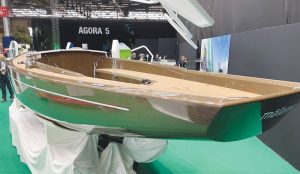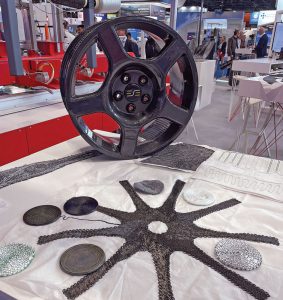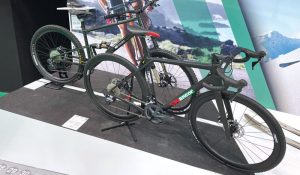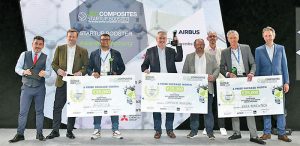
The recent JEC World show in Paris offered participants a view of the industry’s global direction.
By Jim Kaufmann, Contributing Editor
Rarely does one have the opportunity to look into the future especially from a business and technology perspective. However, for those attending the recent JEC World 2023 the future and direction of the composites industry was on full display throughout the show floor. This annual event — held at the Paris Nord Villepinte Exhibition Centre — brings together virtually every segment of the composites industry supply chain from around the world. The 2023 edition welcomed more than 40,000 attendees from 106 different countries to view the exhibits of approximately 1,200 companies. Everything from raw material inputs to fiber reinforcement technologies, resin systems, processing methodologies and final product applications were on full display throughout the exhibit halls.
The depth and variety of innovation found at JEC World 2023 was truly inspiring as were the many different facets of technology and applications in seemingly every direction. There were several highlights, observations and trends that stood out post show.

Sustainability, Recycling and Circularity
Exhibits on the show floor and conversations with attendees made it blatantly obvious that sustainability, recycling and circularity continue to be hot topics. These subjects are directly affecting and influencing the global business climate and the composites industry is not excluded from these influences. Europe has embraced and advanced sustainability efforts much more so than North America has to date. Almost every larger booth and many of the smaller ones at JEC World had some notation or display specific to sustainable practices and products. Numerous fibers, fabrics, resin systems and processing technologies promoted their sustain-able, recyclable and/or circular attributes; while several exhibitors promoted either the ability to recycle their products or showed products that had been produced using recycled content. Interestingly, several of these products included variations using recycled carbon and glass content.
Natural Fiber And Bio-Based Technologies
Driven in part by the sustainability movement, natural fibers — such as flax, hemp, jute and bamboo — as well as green and bio-based resin systems continue to gain stature and support in composite applications. As demand and usage grows, and with improvements in processing and this segment’s supply chain, these natural options demonstrate performance upsides and potentially lower costs than comparable carbon or glass products.
JEC World 2023 featured a dedicated and greatly expanded section of floor space to emphasize the use of natural fibers, such as flax and hemp, in composites, which included examples of what products may be or are being produced using natural fibers. There also was an “Industry Planet Showcase” exhibit area to highlight a variety of impressive applications, including boats, sporting goods and high-performance automotive parts produced from sustainable inputs.

Composite Design, Processing Technologies And Automation Continue To Advance
Numerous advances in composite design, processing technologies and automation were evident on the show floor. Design systems specific to fiber orientation and placement have further evolved and improved. Robotics and automation continue their advancement onto the production floor in order to reduce cost and complexity in addition to improving the accuracy, quality and repeatability of composite parts manufacturing while reducing waste. Also, thermoset resin systems, various molding materials, consumables and other technologies including systematic improvements to the molding process itself bode well for the continued reduction in processing times and resulting costs.
Fiber Placement Continues To Evolve
Enhanced and refined fiber placement technologies, whether with roving or spread tow tapes, were found in several booths and the advances witnessed are impressive as was the complexity of the products generated. Tailored fiber placement (TFP) — a technique based on using sewing machines or embroidery heads to stitch the fiber reinforcement media onto a sacrificial or inclusive backing to create complex preforms — and fiber placement using robotic systems continue to show great improvements and potential in assorted applications. The basic premise for either of these technologies is to place the fiber reinforcement exactly where and to whatever level the application requires it in a repeatable, cost-effective and efficient manner. This allows for more complex shapes and structures to be created without the need for the potential additional costs and likelihood of increased waste associated with using traditional fabric reinforcements.

Spread Tow Tapes Continue to Gain In Popularity
The use of spread tow tapes continues to grow and gain in popularity in both fabric formation and fiber placement segments for composite applications. As discussed previously in Textile World (see “Reintroducing DORNIER’s Composite Systems Suite” TW, September/October 2021), spread tow is a methodology of taking a roving — a large fibrous bundle — and spreading the individual fibers out so as to make thin tapes and allow the filaments to be more cleanly oriented. Using spread tows results in composite parts with higher fiber volume fractions — the ratio of the fiber present to the total volume of the part — and in many cases results in improved performance. Support industries have clearly noticed the spread tow trend. Textechno, a textile testing technology company based in Germany, used JEC World to introduce its new TAPETEST machine. TAPETEST is a commercial testing and evaluation system specifically devoted to the detailed characterization and quality of spread tow tapes.
Differences Found Between The Europe- and U.S.-Based Trade Shows
It was interesting to note some of the differences found between JEC World and other composites-focused shows organized in the United States. Depending on which metric is used, JEC World is probably three- to five-times larger than the Composites and Advanced Materials Expo (CAMX) which will be held this fall in Atlanta, or the Society of Advanced Materials and Process Engineering (SAMPE) event held earlier this year. Exhibitor booths at JEC World are generally larger and more detailed than found at CAMX, SAMPE or even other technical textiles-oriented shows.
Many of the booths at JEC World focus much more on applications rather than technology where the United States tends to want to hide the applications so as to not invite competition. However, Paul Latten, director of research and development at Southeast Nonwovens, Clover, S.C., mentioned that it was interesting to see all of the applications on display. “The examples of applications are what draws people into the booth and elicits discussion, not necessarily the fibers and fabrics,” Latten said. “They are how you get there, but the actual finished pieces are certainly much more interesting.”
Oh, and yes the food available on the JEC World show floor was better, but after all, the event is held in Paris! The use of composites only continues to grow and gain acceptance globally as evidenced by the wide array and variety of technologies, methodologies and composite part applications on display at JEC World.
The event is held in Paris, which some may think of as a “boondoggle trip,” but attending JEC World should not be viewed in that way. Simply stated, attending JEC World is a fantastic way for anyone directly involved in or who may have some level of interest in the North American composites industry to either learn from or gauge where they actually stand in the global composites marketplace and even catch a viable glimpse of what the future will bring.

JEC Composites Startup Booster 2023 Winners
— TW Special Report
During JEC World 2023, winners of the annual JEC Composites Startup Booster were announced. The competition, launched in 2017, is a prominent platform for entrepreneurial ventures in the composites industry worldwide. The competition not only offers a unique opportunity for participating startups but also allows the international JEC World audience to gain inspiration, forge connections and foster business collaborations. Each year, 20 startups with groundbreaking projects utilizing composite materials are selected to pitch their ideas before a panel of expert judges on the renowned JEC World stage. This year, the event featured two pitch sessions, culminating in three category winners.
The Winners
In the “Products & Materials” category, Canada-based INCA Renewable Technologies emerged victorious. For the “Process, Manufacturing & Equipment” category, Switzerland-based Composite Recycling secured the top spot. Finally, Egypt-based Agrona claimed the Sustainability Prize.
The awards not only bring visibility and recognition to the winners, but also provide them with connections to key decision-makers in the industry.
The Jury
The jury responsible for selecting the winners consisted of representatives from major manufacturers and investors including Turlough McMahon, Composite Industrial technologist, Airbus; Karl-Heinz Fueller, manager, Future Outside & Materials, Mercedes-Benz; Raphael Salapete, R&T Plan manager, Ariane Group; Christer Larsson, founding partner of The Impact Fellowship; and Chris Skinner, vice president of Strategic Marketing, Owens Corning.
May/June 2023




